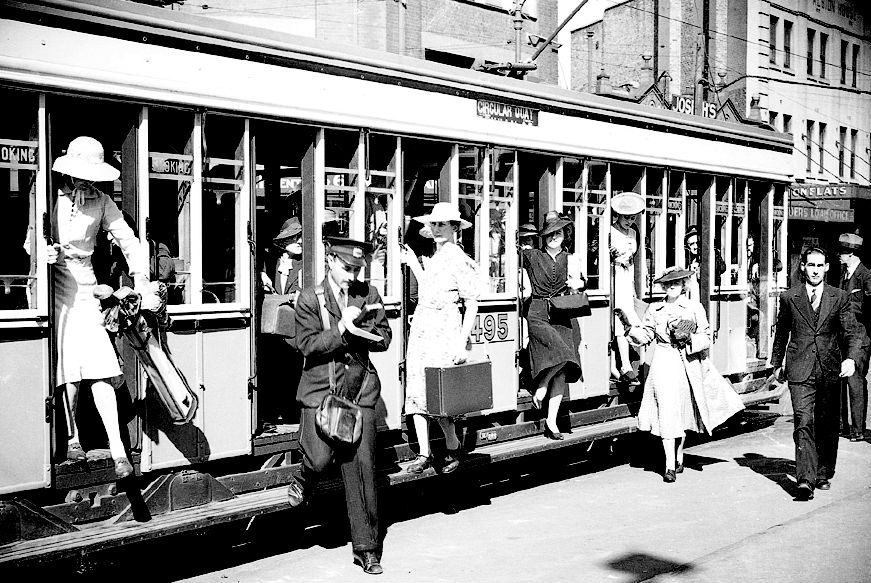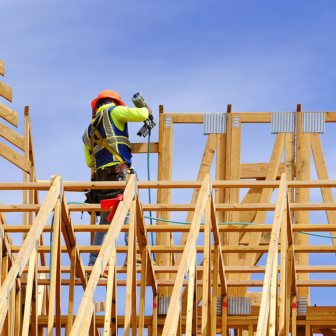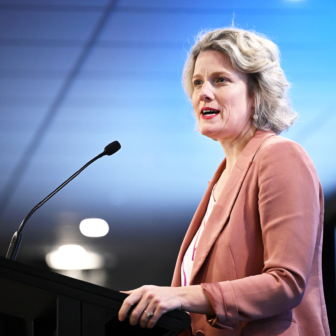Cars began to dominate Australian cities in the 1950s, when mass car ownership became a feature of a booming economy. They still do. Back then, though, public transport still accounted for half of all trips, and the road, rail and tram systems were in public hands. Today, Transurban is the single most important single provider — via its tollways in Sydney, Melbourne and Brisbane — and key decisions about routes are being made primarily in the interests of its shareholders.
The last great high-water mark in public transport investment was in the years between the first and second world wars, when state governments, still in control of income taxes, could afford to electrify the suburban systems of Sydney and Melbourne, build J.J. Bradfield’s Sydney Harbour Bridge and underground railway, and maintain a network of capital-city trams. Since they surrendered their income tax powers to Canberra in 1942, they’ve been strapped for cash, and the federal government has made more and more of the decisions about where public investment goes. Where it’s gone has been into public housing and suburban sewage (at least to begin with) and education, health and interstate roads, but not into public transport.
Melbourne managed to keep its tram system — now the largest on the planet — but all the other cities ditched theirs along the way. What an irony it is that one of the main reasons for getting rid of Sydney’s trams was the road lobby’s complaint that traffic in the city’s main thoroughfare, George Street, was down to five miles an hour. Seventy years later, with traffic once again down to a crawl, the tramline is being rebuilt.
Elsewhere, governments are belatedly attempting to retrofit new rail routes and build new tramlines. Even the Gold Coast, where the Queensland government ripped up the Beenleigh-to-Southport-to-Coolangatta rail line in the early 1960s, acquired a new federally funded line in the 1990s, designed to cope with a predicted population of half a million. More recently, a tramline has been inserted into the Gold Coast highway, with an extension on the way.
But roads have always been the priority. State and federal governments invested billions in urban freeways from the 1960s to the 1990s, and then Transurban came along with offers to inject capital in exchange for long leases. The company didn’t just want ownership; it also wanted remunerative links to publicly owned freeways, with its share of the take maximised by strategically located tolling points.
Victorian premier Jeff Kennett’s thirty-three-year CityLink agreement with Transurban included a clause allowing the company to claim compensation if “new roads or public transport” had a “detrimental effect” on its financial performance. Victoria’s current government has belatedly promised a rail link to Tullamarine airport, its absence being the single biggest dent in Melbourne’s claim to be a global city. One simple accident on the “Tulla” on a Friday afternoon and thousands miss their flights, parents miss closing time at childcare centres and everyone’s temperature rises dangerously.
Tollways and freeways can certainly make longer urban trips much quicker at certain times of the day, but not at peak hour, when adding lanes might increase capacity but rarely diminishes congestion. Part of the problem is that you can’t quickly alter the public transport and road systems, and it is usually hard to increase capacity significantly.
Most of the worst traffic congestion in Australia is no longer in the inner-city areas. It’s on the freeways and tollways, where cars jostle with B-double trucks and tradies’ utes. In the past, traffic problems have been blamed on city-centred road systems, but tollways and freeways — including Melbourne’s ring road, Brisbane’s Gateway system (linking the Gold and Sunshine Coasts) and western Sydney’s M7 — increasingly bypass city centres completely. Even on accident-free days, travel times often double at peak hour. A quick check of Google traffic maps for the morning and evening peak shows plenty of twenty-five-kilometre trips taking an hour or more, especially when tollways intersect with publicly owned freeways, with many lanes of traffic being forced into just a couple of lanes.
Brisbane desperately needs another rail crossing under the river because the current two lines simply can’t cope with the three million people who live in the 200-kilometre city from Noosa to Tweed Heads. Over $3 billion was unaccountably spent on the Clem Jones Tunnel under the city’s Story Bridge without building in a rail link. Instead of the predicted 60,000 vehicles a day, it got 20,000 and went broke, and Transurban eventually picked it up on the cheap. Like the saga of the cross-city tunnel in Sydney, the project showed that the resources spent on an enormously expensive quick fix could have been much better allocated.
Simple bits of infrastructure can make a significant difference. The bus, pedestrian and cycle bridge over the Brisbane River, linking Woolloongabba with the University of Queensland, services 50,000 trips a day — a bargain at $55 million. A high proportion of Brisbane’s busway system, built over the past twenty-five years, runs on bus-only infrastructure, which offers much faster travel times than buses manage in Sydney or Melbourne (though bus-only lanes can also be helpful). The bus-only lanes on the Sydney Harbour Bridge carry more passengers at peak hour than private cars, most of which carry a driver but no passengers. Myriad research studies show that when you ask car drivers to estimate their travel time, and compare it to the same trip on public transport, they rarely calculate the amount of time it takes to find a park once they reach their destination.
Metro-wide planning blueprints should be an opportunity to deal with at least these problems. The latest of these, the Greater Sydney Commission’s forty-year plan (currently at the draft stage), divides Sydney into three “cities” — CBD/Eastern Harbour, Parramatta/Central River and Western Parkland. It promises (or at least hopes) that 70 per cent of people will live and work within thirty minutes of one of these cities by 2056. Because Sydney is built on a semi-circle – the other half is the Pacific Ocean – it has much less room to expand than Melbourne. Chief commissioner Lucy Turnbull’s hero corporations, she told us in her recent Bradfield Oration, are Lend Lease, Westfield and Macquarie Group. They have all made a lot of money, though why success in developing car-based shopping complexes is a guide to a better urban future is beyond me.
Like all such plans, the Sydney blueprint is predicated on certainties — not least that air travel will continue to dominate one of the world’s busiest routes, Sydney–Melbourne, with ten million passengers a year. A fast train, especially if it went via Canberra, would completely undercut that patronage base, but it would require new regional cities along the route, along with legislation to capture the rise in land values, and genuine coordination between the NSW, ACT and Victorian governments, an unlikely prospect. And the owners of the current Sydney and Melbourne airports would be very cross indeed.
Sydney has added a few new rail lines over the past twenty years, with the impetus for the airport line coming from a fear of transport chaos during the 2000 Olympics. One of the most difficult issues in rail planning is the trade-off between speed and the number of stations, so some supporters of the new route from the Sydney CBD to Parramatta, which is central to the Turnbull scheme, want just a couple of stops and a high-speed trip, while others, including key property developers and local councils, would like a dozen stations.
Melbourne still seems to be playing around at the edges in expanding its public transport offerings, with some modest rail additions just announced. Its new trams certainly provide better access for the full gamut of passengers, and getting rid of railway level crossings seems sensible (though road bridge overpasses are pricey). The hope in the 1990s that privatisation would improve rail services has proved illusory and the state government now provides massive subsidies to private operators. Many of the larger inner-city stations, most notably Footscray’s, have been rebuilt and some new suburbs, especially in the west, have been given better rail access via new stations on existing lines.
It’s easy to forget that transport has enormous equity implications. At any one time, at least a third of the population can’t drive because they are too young, too old or incapacitated in some way, or because they can’t afford a car or, heaven forbid, don’t want to own or drive one. A bunch of futurists tell us that electric cars, self-drive cars, and now Jetsons-style personal air transport will solve all our traffic problems. In reality, cities and congestion will always go hand in hand, and morning and evening peak hours are inevitable. Cities that don’t suffer massive congestion have either had a vast amount of public money spent on their road system compared to their population (Canberra) or experienced a relatively static population (Adelaide). The range of trips people take in cities — to go to school, to shop, to eat out, to spend time at the beach, to visit friends and relatives — won’t change too much, even with the rise of home delivery of shopping and meals. Remember when pundits were telling us we would all be working at home by now?
The federal government has finally recognised the necessity of more public transport investment, but right now most of the new housing estates on our urban fringes still follow the major road routes, and households still have to rely on their cars. Developers are also making hay with “transport-oriented” high-density apartments near public transport. But investors in inner-city apartments, who account for well over half the market, still insist on car spaces, and many of these developments are causing an exponential increase in traffic despite the fact that most residents live within a few minutes of a tram, bus or rail stop. This leaves us with a growing number of high-rise apartments abutting major roads and freeways. You can escape the noise with double glazing and air conditioning, but why on earth would anyone want to venture out onto a balcony overlooking constant traffic? Still, the developers love adding those balconies, a last gasp of defiance against climate change.
For too long we’ve let public transport play second fiddle to roads and cars. We’ve conned ourselves into thinking that a car-owning democracy offers choice and freedom of movement. But not at peak hour, not at holiday time and not when there has been an accident. Instead of relying on freeway-driven development in our outer suburbs, we should return to new suburbs being built around a growing rail and light rail system, as they were from the 1880s to the 1950s. And walking should again become a valued activity, without having to play second fiddle to motorists or even cyclists, neither displaying much respect for pedestrians ⦁




